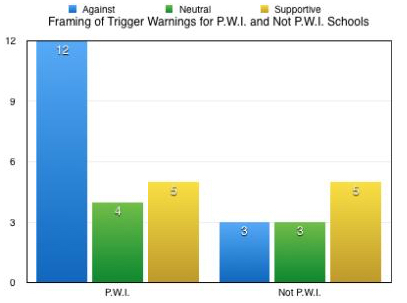This post was submitted by Tim Englehart ’18, Sociology major.
This semester I worked with two other students, Sally Langan ’17 and Valeria Felix ’18, to study the conversation surrounding the use of trigger warnings on college campuses as a project for Professor Henke’s “Media Frame and Content Analysis” course (SOC 251). A trigger warning can be defined as a statement that comes before a piece of writing, a movie, or a speaker or discussion that alerts the audience that the material presented may be stressful or evoke a traumatic response from past experience. Proponents of trigger warnings argue that they protect students from emotionally harmful content and in doing so create spaces in which students can feel safe to engage in critical discussions and learning. Critics of trigger warnings argue that such warnings contradict the ideal of free speech, and that exposure to uncomfortable situations is an experience that facilitates learning and growth—allowing students to avoid discomfort in the classroom detracts from their educational experience.
The public debate over trigger warnings has been a contentious one; in September of 2016, The Atlantic published a scathing article against the use of trigger warnings, calling college students coddled and childish. In August of 2016 the Dean of Students at the University of Chicago wrote a letter to incoming students condemning the use of trigger warnings on campus, only to spur a letter published by over 150 faculty members at the university defending such warnings.
For our research project we were especially interested in studying how students themselves talked about trigger warnings. We conducted content analysis on a random sample of over 30 articles discussing trigger warnings, published by student-run college newspapers since the beginning of 2015. Using the coding software MAXQDA we read through each article and sorted the content into codes representing common themes in each article about trigger warnings. Identifying negative codes such as “Restrict Free Speech” and positive codes such as “Help Promote Inclusion and Diversity,” we were able to examine not only which publications supported and opposed the use of trigger warnings, but also the rationale for either supporting or opposing them.
The main goal of our study was to determine associations between types of institutions included in our sample and opinions on trigger warnings published in campus newspapers. We looked at a few factors to compare the articles from different types of schools: institution size, whether the institution is public or private, the school’s prestige, and whether the institution is predominantly white (50% or more of the student body) as factors that may impact how trigger warnings are portrayed in student publications. Though our sample was relatively small, our main findings show that:
- Publications from large universities are generally more opposed to trigger warnings than those at smaller colleges.
- Predominantly white institutions are generally more opposed to trigger warnings than institutions composed of less than 50% white students (see chart below).
- While publications at both public and private colleges are more likely to oppose the use of trigger warnings than to support them, they do so for different reasons:
- Publications from private institutions generally oppose the use of trigger warnings because of their capacity to allow students to avoid classroom discomfort.
- Publications from public institutions tend to oppose the use of trigger warnings because of their potential to limit free speech.

Coverage of trigger warnings at predominately white institutions (PWIs—where white students comprise more than half of the student body) tends to be more negative than in news coverage from non-PWI student papers.
Our project was exciting because the conversation about trigger warnings is a relatively new one, and also because this is an issue that directly affects students and their well being. Through college news media, we were able to directly examine how other students are talking about trigger warnings. We hoped to shed light on the external factors that are driving the debate over trigger warnings on campuses and examine how students see these warnings in relation to the ideals of diversity, inclusion, and free speech.

